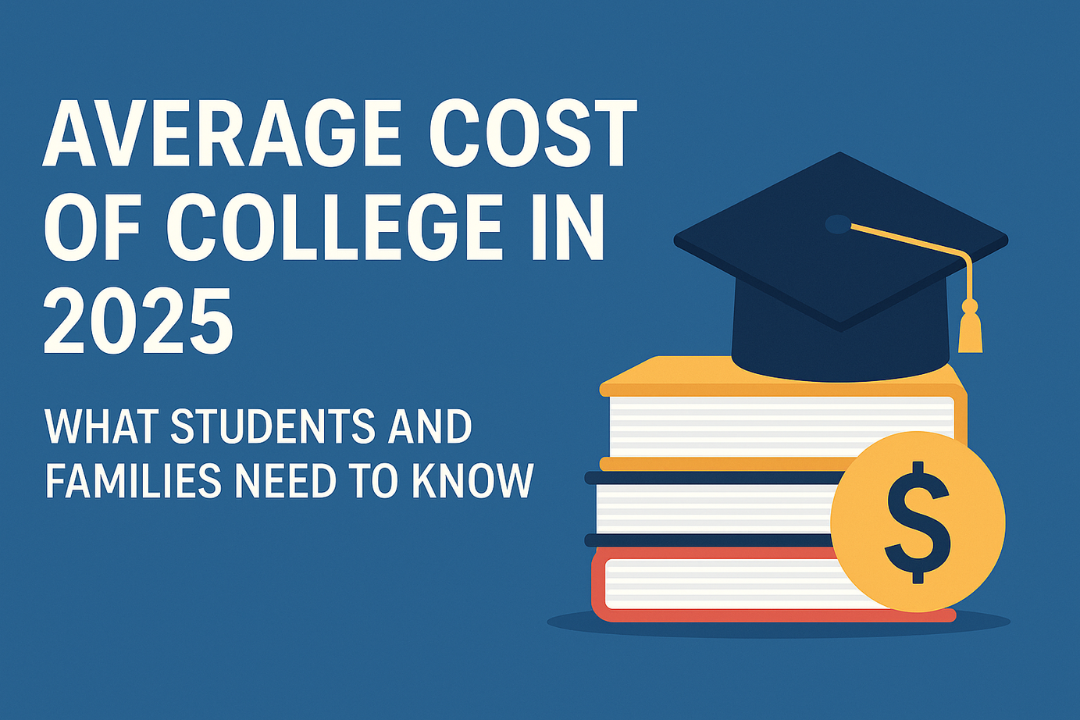Understanding the Real “Average Cost” of College in 2025
When families talk about college affordability, they often ask a deceptively simple question: “How much does college cost?” The truth is, there’s no single number because the cost depends on where you study, whether you live on campus, and how much financial aid you receive.
Still, knowing the national averages helps you plan realistically. In 2025, the average total cost of attendance (including tuition, fees, room, and board) is about $28,500 per year for public in-state students and roughly $58,200 for private nonprofit universities, according to data from the College Board’s Trends in College Pricing Report (2024–2025) and the National Center for Education Statistics (NCES).
Those numbers represent the full sticker price before scholarships or aid. They’ve also been rising faster than general inflation, typically about 3–4% per year, according to EducationData.org, which tracks long-term tuition trends in the United States.
But remember, very few families actually pay the sticker price. Thanks to scholarships, grants, and institutional aid, many students pay significantly less. The key is knowing where those savings come from and how to find them early.
College Costs by Institution Type: Public, Private, and Community Colleges
The type of school you choose has the biggest impact on what you pay.
At public four-year universities, in-state students currently face average tuition and fees of about $11,610 per year, while out-of-state students pay closer to $30,780, according to the College Board (2024–25). Private nonprofit colleges charge around $43,350 on average, but those higher prices are often balanced by more generous financial aid.
Community colleges remain one of the most affordable entry points into higher education. The average in-district tuition for a two-year public college is about $4,000 per year, based on College Board and Education Data Initiative.
Here’s how these categories compare overall in 2025:
For families comparing options, this table tells an important story. Out-of-state tuition can be just as expensive as many private colleges, while starting at a community college can significantly reduce total costs.
How College Costs Have Changed Over Time
If it feels like college has gotten more expensive every year, you’re not imagining it. The cost of higher education has grown much faster than general inflation.

According to the College Board’s Trends in College Pricing Report, tuition at four-year public universities has roughly tripled since 1990, even after adjusting for inflation. Several factors drive this increase: declining state funding, expanding campus amenities, technology investments, and greater demand for student services such as mental health and career counseling.
In 2000, the average in-state tuition at a public university was just over $4,000. By 2025, it has nearly tripled. The U.S. Inflation Calculator shows that education costs have consistently outpaced general consumer inflation. For families, this means budgeting with a realistic understanding that tuition will likely rise each year you’re enrolled.
Breaking Down the Full Cost of Attendance
Tuition is only part of the picture. The total cost of attendance (COA) includes housing, food, transportation, books, supplies, and personal expenses.
According to the Education Data Initiative, the average cost of room and board in 2025 is between $13,000 and $16,000 per year, depending on location and living arrangements. Books and supplies usually add $1,000 to $1,200, while transportation and personal expenses can exceed $2,500 annually.
Together, these additional costs can equal or exceed tuition, especially for in-state students at public universities. This is why budgeting for everything, not just classes, is crucial.
A practical strategy is to calculate the total cost of attendance early and then look for ways to save. Living at home for a year, renting textbooks, using meal plans wisely, or opting for public transportation can all help reduce your overall expenses.
Financial Aid, Grants, and Scholarships: How Students Offset the Cost
The rising price of college is real, but so is the relief that financial aid and scholarships can provide. Most students receive some form of assistance that lowers their net cost.
The first step is always the FAFSA (Free Application for Federal Student Aid). Completing it early each year determines your eligibility for federal and state aid, institutional grants, and even some private scholarships. Programs like the Federal Pell Grant can cover thousands of dollars annually for students with financial need, and unlike loans, they do not have to be repaid.
Colleges also award merit-based and need-based scholarships, and private organizations contribute billions each year. That’s where Scholarship Nerd makes a difference. We curate verified scholarships to save you hours of research and help you avoid scams.
Pro Tip: Start applying for scholarships as early as possible, even in your junior year of high school. Early applications build confidence and improve your chances of success.
You can explore verified scholarships right here on Scholarship Nerd or check out our “How to Pay for College Tuition” guide for step-by-step help on reducing costs.
Is College Still Worth the Cost in 2025?
It’s a fair question. When tuition and housing can add up to more than $100,000 over four years, is the investment still worth it?
In most cases, the answer is yes. According to the U.S. Bureau of Labor Statistics, college graduates continue to earn significantly more than those with only a high school diploma — on average, about $1 million more over a lifetime. Beyond income, graduates also experience lower unemployment rates, higher job satisfaction, and greater career flexibility.
That said, the value of college depends on your personal goals and financial plan. A degree in engineering or nursing from an affordable public university may yield greater returns than an expensive private degree in a lower-paying field.
For others, trade schools, apprenticeships, or online programs can be better options. What matters most is choosing a path that aligns with your career goals and financial situation.
Key Takeaways: Planning for College Costs with Confidence
College costs in 2025 can feel daunting, but knowledge is your strongest financial tool. Understanding what contributes to the price, planning for all expenses, and pursuing scholarships and aid can make higher education achievable.
To recap:
- The average total cost of attendance for public in-state students is around $28,500, and private college averages about $58,200, based on College Board.
- Tuition continues to rise each year, but most students pay less after aid and scholarships.
- Community colleges offer a practical, affordable route that can lead to four-year degrees with lower debt.
- Smart planning, early budgeting, and comparing net prices are key to staying in control of costs.
Ready to take your next step?
Explore verified scholarships to start reducing your costs today.




